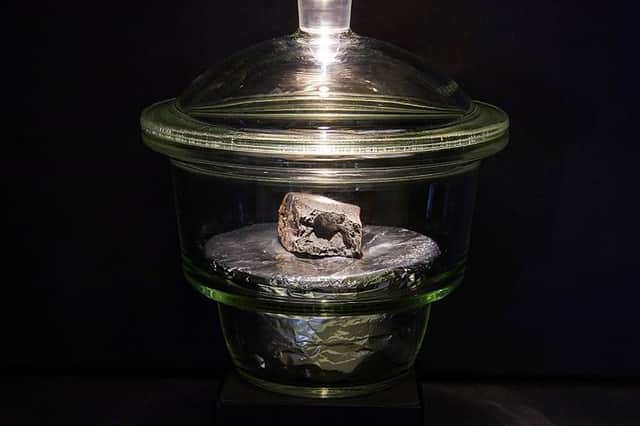Winchcombe meteorite: where is the space rock that landed in Gloucestershire on display - and what is its value?
This article contains affiliate links. We may earn a small commission on items purchased through this article, but that does not affect our editorial judgement.


From Monday (17 May), members of the public will be able to see perhaps the single most famous piece of rocks in the whole of the UK.
The Winchcombe meteorite, named as such after the town it was discovered in, is the first meteorite to fall and be recovered in the UK for 30 years - and the first of its kind to ever be recovered in the UK.
Advertisement
Hide AdAdvertisement
Hide AdWhen was the meteorite discovered?
The meteorite fell to the Gloucestershire town of Winchcombe back in February. At the time, many videos captured the incoming fireball and researchers were able to identify where in England the rock had landed.
Victoria Bond who owns the land that the meteorite was discovered in, was shocked by the find. She had given permission to scientists to do a systematic sweep, but didn’t think anything would come of it.
She said: “They were moving like zombies, pacing back and forth in a line, looking for the meteorite. And as I left that morning in my car, I could see them jumping for joy.
“How they find it is amazing. I’m thinking of putting a plaque in the field because the footpath, the Cotswold Way, is no more than 100 yards away.”
Advertisement
Hide AdAdvertisement
Hide AdThe discovery on Bond’s land, who donated the rock to the museum, was the largest piece of rock fragment found of the meteorite. Now the museum has many more pieces in it’s collection now, around 500g - the majority of which comes from the driveway of the Wilcock family.
Speaking to the BBC, Hannah Wilcok said: “When I heard it drop, I stood up and looked out the window to see what was there, but because it was dark, I couldn’t see anything.
“It was only the next morning when we went out that we saw it on the drive - a bit like a kind of splatter. And in all honesty, my original thought was - has someone been driving around the Cotswolds lobbing lumps of coal into people’s gardens?”
Hannah, her father Rob and mother Cathryn, carefully collected some of the debris, with museum scientists coming out to sweep up the remaining dust using a toothbrush and an empty pot of cottage cheese.
Advertisement
Hide AdAdvertisement
Hide AdWhere will the meteorite be put on display?
A piece of the Winchcombe meteorite will be put on display at the Natural History Museum in London. The museum will be open to the public from 17 May.
Dr Helena Bates, Interim Curator of Meteorites at the museum, said: “This is the first meteorite to fall and be recovered in the UK for 30 years, and the first meteorite of its type to ever be recovered in the UK.
“The meteorite has an incredible four and a half billion year history, and look at it is like peering back in time to the beginning of our solar system
“Despite being quite an unassuming piece of black rock, I hope when people see it they remember they are looking at something that is probably older than our planet.
Advertisement
Hide AdAdvertisement
Hide Ad“It is truly a success for the future of planetary science and having the joy of looking after it is probably the most exciting thing that will ever happen in my career.”
The museum describes the 103-gram fragment of black rock as “an extraordinarily exciting discovery”.
How much is the meteorite worth?
It’s incredibly rare for a meteorite to be recovered in the UK, this specific type of meteorite is known as carbonaceous chondrite, and out of 65,000 known meteorites in the world, only around 1,000 are of this specific variety.
According to The Times, the meteorite is estimated to be “worth tens of thousands of pounds”.
Advertisement
Hide AdAdvertisement
Hide AdGeology website, Geology, explains that meteorites are usually sold by weight and, as is the case with most collectable items, the value can increase due to a number of factors, such as its rarity, condition and aesthetic appeal.
Additionally, “witnessed falls” typically go for a higher price as well.
